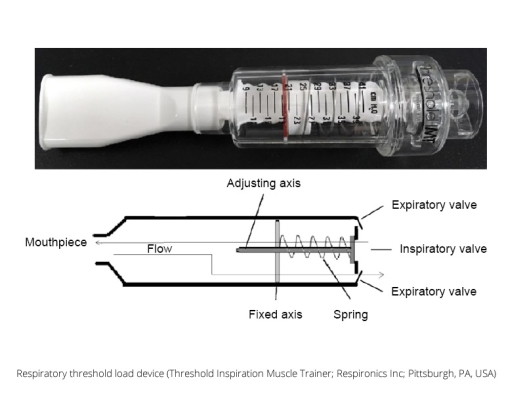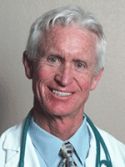ThresholdInspirationMuscleTrainer.jpg

Threshold Inspiration Muscle Trainer; Respironics Inc; Pittsburgh, PA, USA / CC BY-NC 3.0
Respiratory threshold load device
Three weeks ago, I saw a 65-year-old woman, I’ll call her Pat, for her annual check-in. She had been consulting with me for a number of years for several problems, one of which was chronic lung disease (COPD).
COPD is frequently a difficult problem to deal with because by the time patients start to look at getting help, the disease has often progressed too far. In her case, while I did not expect her to tell me she was improving, I did have hope that her condition was no worse. But what she reported to me has opened my eyes to a new way of treating lung diseases that I never knew about.
Respiratory diseases like COPD are one of the leading causes of death worldwide. An amazing four million people die every year due to chronic respiratory conditions which include COPD, bronchiectasis, pulmonary fibrosis, and pulmonary hypertension. The defining symptom of these diseases is shortness of breath even with relatively minor exertion.
Of course, the obvious treatment for these diseases is to treat the cause or causes. We can do that with ozone therapy, glutathione and NAC nebulization therapies, nutritional therapy, and stem cell therapy. But as I said, even when the cause is eliminated, the damage done is often irreversible. That was the condition that Pat found herself in.
So, I was surprised to hear her tell me that she was breathing a lot better and was able to go on hikes that would have been impossible a year ago. What did she do? Was it some kind of Big Pharma miracle drug? No, it was something completely different.
It was inspiratory muscle training or IMT. I had vaguely heard about this therapy but had never actually talked with a patient who had benefited from it, much less had the remarkable improvements that Pat saw. So I looked it up and found this study.
Researchers looked at 10 patients ranging in age from 27 to 89 years who were unable to get a full breath. Five patients were diagnosed with COPD, two with bronchiectasis, and three with pulmonary fibrosis. The researchers had them breathe through a device that was able to measure how much force their chest and abdominal muscles were able to generate when they were taking a deep breath as hard as they could. In other words, they measured how strong their breathing effort was. Not surprisingly, all of them had noticeable inspiratory muscle weakness.
Then they had them exercise and strengthen their breathing muscles using an IMT device that created a resistance to taking a deep breath similar in concept to breathing as hard as you can through a small tube. In effect, this was just like taking a person with a weak arm and having him strengthen the muscles in the arm by exercising against resistance. It was basically resistance training for the breathing muscles.
The IMT device is a small handheld device that is placed in the mouth. The patients were instructed to perform deep and vigorous inspirations as hard as they could. As I mentioned before, the device creates a resistance to the breathing effort which can be adjusted according to how weak the breathing muscles are. The IMT protocol consisted of taking 30 breaths, resting for one minute, and then repeating another 30 breaths. This was done twice a day for 8 weeks. As the patient’s breathing became stronger, the resistance was gradually increased. All the treatments were done at home without supervision. Here’s what happened.
At the end of the 8 weeks the patients were questioned regarding; (1) impact of inspiratory muscle training on breathlessness (e.g., "I wasn't feeling as tired as I previously felt."); (2) change in daily activities (e.g., "I needed to go to the supermarket, I felt less tired doing it."); (3) improved mobility (e.g., "I could not stand for long periods ... walking, for example ... Now I stand more, I have more capability."); and (4) increased communication (e.g., "More power, right? Even in speaking ... When I could, I felt my voice coming out better."). The outcome? Every patient improved in every category. So why does it work so well?
Chronic lung disease does not come on suddenly. It comes on very gradually. And as it becomes harder and harder for people to breathe, they get less and less exercise, and their respiratory muscles begin to weaken. Combine this with the fact that weak breathing is a hallmark of the aging process, and it is easy to understand how rapidly the respiratory muscles can become weaker and weaker over time, especially in older people.
As that happens, the assumption often is that the breathlessness that comes with it is entirely from the disease when in fact it is a combination of the disease and the progressing weakness. IMT exercise acts to correct the respiratory weakness part of the equation and in some cases can dramatically decrease breathlessness and improve overall stamina.
The researchers did not report it in this study, but in other studies IMT has been shown to strengthen the inspiratory muscles as demonstrated by an increase in maximal inspiratory pressure and overall respiratory strength. Furthermore, this was not the only study showing marked improvement with IMT. Several meta-analysis studies have demonstrated the same results. And the good news is that even very old patients with extreme respiratory weakness can benefit.
The IMT device used in the study is called a K-3 Series Powerbreathe. You can learn more and buy one at www.powerbreathe.com. The device Pat used was a similar device called “The Breather.” You can find that one at www.pnmedical.com. By the way, remember that in this study, the patients only used the device for about five minutes twice a day for 2 months to see significant results. How much better would they have been had they used it for a year or two? Two more things.
One, IMT is also effective for patients with asthma, high blood pressure, heart disease, neuromuscular disease, pre- and post-op surgery, COVID recovery, swallowing difficulties, aspiration problems, and post stroke.
Two, IMT devices are also effective as athletic training devices, increasing strength, power, and stamina. Research into inspiratory muscle training and exercise performance shows that four weeks of IMT fitness training brings about a universal reduction in whole-body effort sensation. That means that athletes can push themselves a bit further, increasing their training intensity and getting fitter faster. Research from Brazil found that athletes breathing against a small inspiratory load right after exercise reduced their lactate levels by 16%.
This is one treatment that makes perfect sense. It works and anyone with lung issues or who wants to improve performance should try it for at least 2 months.
Reference
Hoffman M, Assis MG, et al. The effects of inspiratory muscle training based on the perceptions of patients with advanced lung disease: a qualitative study. Braz J Phys Ther. 2018 May-Jun; 22(3): 3): 215–221.
"A New, Highly Effective Way to Treat Lung Disease" was originally published in Dr. Frank Shallenberger’s Second Opinion newsletter, August 2022. Used with permission.


